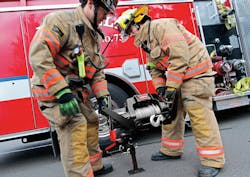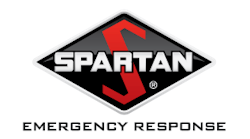Apparatus Winch Selection Is Driven by Mission
Winches are staples of rescue and emergency response vehicles and they have been for decades. They have, however, evolved over the years. While the big front-mounted hydraulic-driven beasts are still around, they are increasingly being traded for portable, receiver-mounted, electric-powered units that can be affixed to either side as well as front and back.
“It’s much more common today to see side-mount winches,” said David Brass, general industrial sales manager for Warn Industries, in Clackamas, OR, one of the nation’s leading makers of winches for the fire service. “In many cases, you see receivers on all sides of the apparatus. The uses of multi-mount winches that utilize a cradle attached to a receiver allows the winch to be moved to any side of the apparatus.”
In the past, it was very common to see winches mounted on the front of the apparatus and it’s still popular with some fire departments. Many, however, like the convenience of moving the winch rather than having to turn the apparatus around to get the winch pointing in the right direction, Brass said.
“You don’t need to tie up traffic by blocking the whole road,” Brass said. “And, the electric winches have much faster deployment in many cases.”
Bob Sorensen, vice president of sales for SVI Trucks in Fort Collins, CO, has also noticed an uptick in portable winches being employed by fire departments.
“The portable winches seem to be in vogue,” Sorensen said. “Ninety percent of the heavy rescues still have big winches on the front, but most also have portable winches as well.”
Brian Connely, the national sales manager for Spartan ER, in Brandon, SD, says it’s important to think about what the winch will be used for when specifying them.
“In general, when you talk about winches, you have to think about what the mission is,” Connely said. “Are you a true rescue company? Are you an engine company? What are you expecting to do?”
Connely said too often, firefighters will specify a winch on an apparatus and “think they can lift up a mountain.”
“What loads are you going to be handling?” Connely asked, noting that capacity limitations and expectations will govern whether the mission can be achieved with a portable winch or if a beefy front-mounted winch is more appropriate.
Sorenson said his company recently worked with Sutphen, an apparatus builder in Amlin, OH, to build a heavy rescue that was sent to China and it had a 20,000-pound rated hydraulic winch on the front. He was also working with a local department that wants a 25,000-pound winch.
Brass said most of the portable winches are rated at 9,000 to 10,000 pounds, which is plenty for most applications on an emergency scene. It’s enough to pull a burning dumpster away from a building, or stabilize a vehicle for extrication.
“You wouldn’t want to use it to pull a vehicle out of a river, but you could use it to stabilize the vehicle,” Brass said, noting that responders’ missions are to rescue people, not recover vehicles. There are other vehicles, like rotator wreckers, to do that kind of heavy lifting.
He added that portable winches can keep rescuers safe, through stabilization, and are also are good for moving debris out of roadways or at scenes where tornadoes or hurricanes have blown through.
Another use for winches is on wildland fire apparatus, Brass said. Vehicles used in wildland applications are often Ford F550s and Brass said a 15,000-pound rated winch should be able to help firefighters extricate their own vehicle should it become stuck. Often, wildland apparatus are completely isolated from other apparatus, working on different sections of a fire, so being able to get unstuck by itself can be critical.
For rescue vehicles, portable winches are most often stored in apparatus compartments, typically a front compartment, where they are out of sight and deployed when needed, Brass said. They are easily moved by one person, but in most cases, two people for deployment is better.
The winch cradle is pinned into the receiver of choice on the apparatus and are driven by 12-volt power from the apparatus, Brass said. In most cases the receiver is a Reese-like square receiver, just like motorists might find on their pickups for trailer hitches.
Picking the locations and making sure the mounts are rated for the capacity of the winch is the responsibility of the apparatus builder, Brass said.
Sorensen added that it’s important to have the proper mount, securely attached to the apparatus and to have the right winch capacity matched to the weight of the apparatus upon which it is connected. A winch that is too big for the apparatus to which it is mounted can mean the rig will break traction and start slipping with potentially catastrophic results, Sorensen warned.
Connely agreed and said manufacturers can either make or purchase receivers rated for the capacity of the winch.
“It’s important how those things tie in and are mounted,” Connely said. He added responders need to remember that rescue vehicles and engines are not cranes and both have limitations.
Connely said he’s noticed an increase in requests for upper and lower tie offs on apparatus, both rescues and engines. He said rescuers are recognizing the value of having purchase points from which cables can be secured on the top of the apparatus to get some height for stability and high angles.
Winches that are carried on, but can be used independently from the rig, are also catching on in popularity, Brass said. Warn offers a portable winch called a “PullzAll” powered by a 24-volt battery pack. The device can be deployed in disaster areas where there’s no power, or for rapid vehicle extrication or to lift items trapping people.
“It can make the difference between losing someone and saving someone,” Brass said.
Another newer product is synthetic rope, which is an alternative to steel wire cables that store energy during use and can recoil with dangerous results if broken, Brass said. He said they have the same ratings as steel wire cables, but are far safer.
“There’s been a rapid acceptance of synthetic rope,” Brass said. “When a (steel) wire rope breaks, the stored energy creates a potentially dangerous situation for responders.” Brass explained that if a synthetic rope breaks, there is no stored energy in a recoil.
“If a fire department has been trained extensively in using a winch, having synthetic rope would be beneficial,” Brass said.
Additionally, the synthetic rope floats during water rescues and it is much lighter weight, Brass said.
There are, however, some down sides to the synthetic rope. Brass explained that the synthetic rope is subjected to UV degradation although there are UV blocks impregnated in the material to help curb the problem. Also, it’s not fireproof and will burn if subjected to fire, he said, and it’s several times more expensive then steel wire cable. Fire departments will have to consider the pros and cons of the synthetic rope when specifying a winch.
Sorensen, from SVI, thinks the synthetic, or nylon rope is worth considering for the safety it offers over the more traditional wire cables.
Brass added that no matter what department chooses, training is critical to having mission success. He said there are a number of individuals and programs offering winch training resources to responders.
“In order for a tool to be valuable, those who use it have to have access to training,” he concluded.









